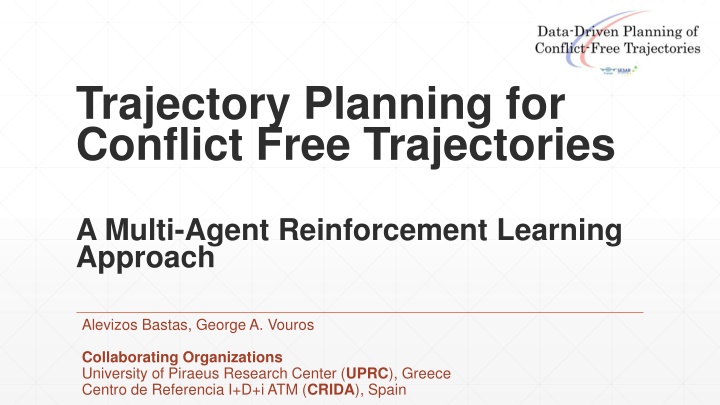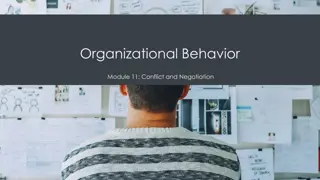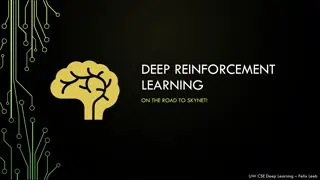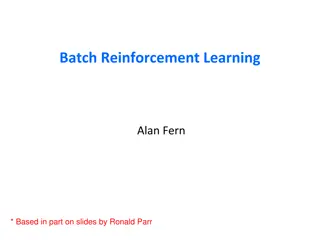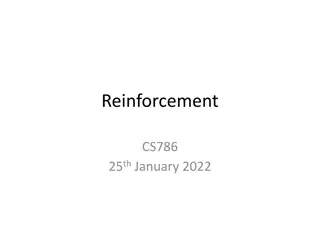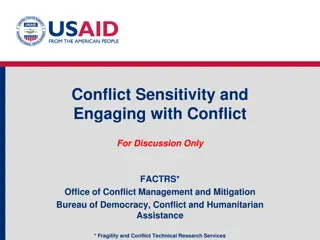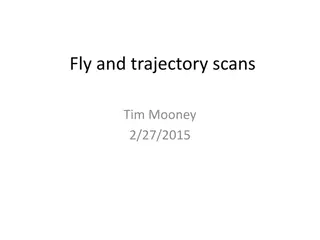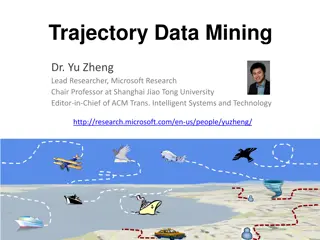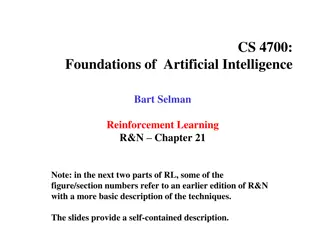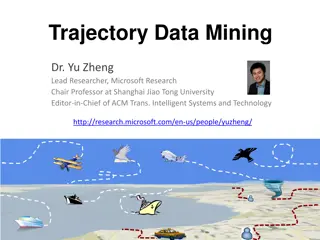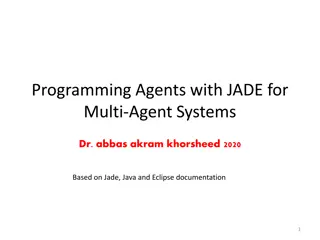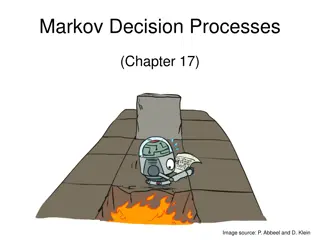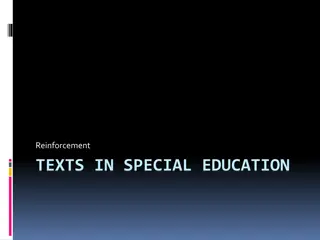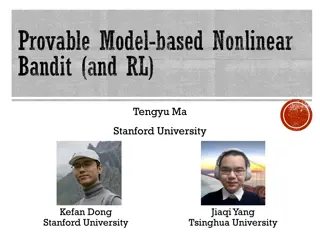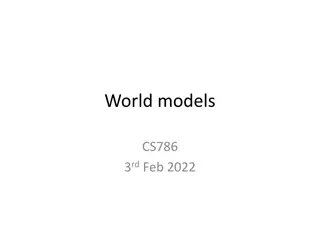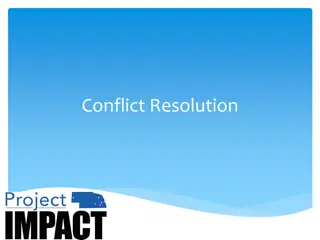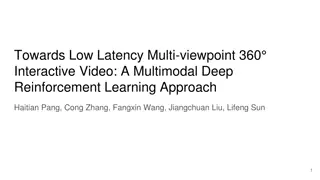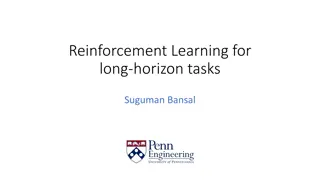Conflict-Free Trajectory Planning Using Multi-Agent Reinforcement Learning
This research focuses on planning conflict-free trajectories for multiple agents using a combination of data-driven and agent-based approaches. The objective is to increase predictability, reduce workload, resolve conflicts, and enhance operational efficiency in airspace management.
Download Presentation

Please find below an Image/Link to download the presentation.
The content on the website is provided AS IS for your information and personal use only. It may not be sold, licensed, or shared on other websites without obtaining consent from the author.If you encounter any issues during the download, it is possible that the publisher has removed the file from their server.
You are allowed to download the files provided on this website for personal or commercial use, subject to the condition that they are used lawfully. All files are the property of their respective owners.
The content on the website is provided AS IS for your information and personal use only. It may not be sold, licensed, or shared on other websites without obtaining consent from the author.
E N D
Presentation Transcript
Trajectory Planning for Conflict Free Trajectories A Multi-Agent Reinforcement Learning Approach Alevizos Bastas, George A. Vouros Collaborating Organizations University of Piraeus Research Center (UPRC), Greece Centro de Referencia I+D+i ATM (CRIDA), Spain
Contents Phd Objective Operational Context Specific objectives methodology What has been done so far Imitation learning for Conflicts Free Trajectory Planning Problem formulation Modelling ATCOs reactions Evaluation Concluding remarks What has been achieved Next Steps
Phd objective Explore and present novel algorithms towards planning conflict-free trajectories at the pre-tactical phase of operations in computationally efficient ways, for large number of trajectories following a methodology combining data- driven and agent-based approaches. Data-driven: Revealing patterns of the stakeholders behavior from historical data generating conflict free trajectories . Agent-based: Agents, representing flights, aim to evolve conflict free trajectories jointly with others.
Operational Goals Increase predictability of trajectories, in conjunction to detecting and resolving potential conflicts among trajectories Eliminate potential en-route conflicts at the pre-tactical phase Reducing ATCO s workload Enabling them to deal with complex traffic situations Increasing the capacity of airspace Reduce the mismatch between planned and flown trajectories Reduce uncertainty of operations Better planning of operations for Airspace Users, etc
Operation context envisioned 5 3 NM proposes Conflict Free Trajectory Sends accepted trajectory to ATCOs Network Manager ATCOs AUs 1 2 4 constructs a flight plan that sends to the NM Historical CF trajectories ATCO events Contextual data such as weather AU accepts the proposed trajectory Production of Conflict Free trajectories
Specific objectives - methodology Prediction of trajectories at the pre-tactical level Resolve conflicts between predicted trajectories, taking into account uncertainties of trajectories evolution in a multi-agent setting (one agent per flight) Using a combination of Data-Driven methods that, based on historical data, learn Patterns of trajectories evolution and patterns of applying conflict resolution actions Agent-Based methods using Reinforcement Learning methods towards Predicting conflict-free (CF)Trajectories
Specific objectives methodology- workplan
What has been done so far Trajectory prediction1: Formulated the trajectory prediction problem (per origin destination pair) as an imitation learning problem where: Given historical 4D aircraft trajectories whose states include 3D aircraft position with timestamps, in conjunction to forecasted weather conditions at each state. We derive, using Imitation Learning (GAIL) a description of how the aircraft is to transit among subsequent states starting from an initial state and on as a function of: (a) the current flight conditions (an initial state with forecasted weather conditions) (b) a forecast of weather conditions at specific positions Conflict Resolution: We formulate the problem of conflicts free trajectory planning as an imitation learning problem, aiming to learn ATCO reactions. Formal Specification of the problem of modelling ATCO s behavior: Predicting when the Air Traffic controller will react towards resolving a conflict, and how he/she will react. Use a deep learning method for predicting ATCO reactions; 1. Bastas, Alevizos, Theocharis Kravaris, and George A. Vouros. "Data Driven Aircraft Trajectory Prediction with Deep Imitation Learning." arXiv preprint arXiv:2005.07960 (2020).
Imitation learning for conflict free trajectory planning
Preliminaries-Imitation learning Agent: Autonomous entity making decision according to its interests also in collaboration with others. Environment: The world in which the agent operates. Policy: A function mapping states (or observations from states) to distributions of actions. Imitation learning: The problem of learning a policy to act according to the behavior demonstrated in the dataset. dataset environment policy agent
Conflicts Free Trajectory Planning-Problem formulation Given: A set of historical trajectories with the corresponding historical ATCO actions We want agents to learn a policy close to the demonstrated ATCO behavior: Generating flight trajectories close to the demonstrated historical trajectories under specific circumstances (e.g. weather conditions) Generating ATCO resolution actions for potential conflicts according to demonstrated historical ATCO resolution actions
Focus: Modelling ATCO s reactions Considering a single agent problem (corresponding to the focal trajectory) ATCO res action point The focus is on predicting 1) when the ATCO would issue a resolution action i.e., determining the exact time point tA, s.t. t tA tc , for issuing a resolution action positiont and 2) how the ATCO would react (which resolution action the ATCO would issue, if any) i.e., deciding the resolution action to be applied (if any) Focal trajectory
When to react: ATCOs modes At each time point t while the trajectory evolves the ATCO may detect a conflict and decide whether he/she will issue a resolution action. According to that we consider the following modesof ATCO s behavior : C0: No conflict no resolution action C1: Conflict detected, and resolution action applied C2: Conflict detected but no resolution action applied at this point Aiming to predict when a resolution action will be applied, we aim to predict the the ATCO mode of behavior at each each time point t as the trajectory evolves.
Predicting ACTOs Reaction Computational Approach : Variational Auto-Encoder (VAE)1 C0: No conflict no resolution action C1: Conflict detected, and resolution action applied C2: Conflict detected but no resolution action applied at this point Decoder Encoder q t0 t1 tT t2 ? ?,? = ?ct~?, ????~?????log atst,ct ????? 1??~????????? ctct 1,st 1. Kingma, Diederik P., and Max Welling. "Auto-encoding variational bayes." arXiv preprint arXiv:1312.6114 (2013).
State Observations (per neighboring flight) ? distance from fixed point bearing relative to fixpoint horizontal speed vertical speed altitude sin(? ?) cos(? ?) ? ?? ???????? ???? ???? ??? ??? sin(??) cos(??) sin(??) cos(??) CPA 1. Dalmau, Ramon, and Eric Allard. "Air Traffic Control Using Message Passing Neural Networks and Multi-Agent Reinforcement Learning." Crossing point Relative Angles between ownship and neighbor
Actions to be predicted ?0:?? ?????????? ?????? ?1:?????? ?? ???????? ?2:????? ? ???? ?:? ???? ?? ?????? ? :? ???? ?? ????????? ????? ??:? ???? ?? ???????? ????? ?:???? ?????????? ?? ? ? ???? ?????????? ?????
Training the model: Dataset s Inherent limitations The dataset comprises: Historical flown trajectories Historical ATCO resolution actions Dataset inherent limitations Does not include the features that cause the ATCO reactions Dataset imbalance w.r.t. modes of ATCO behaviour.
Resolving datasets inherent limitations How to reveal the ATCO observations. Simulating uncertainty in trajectory evolution How to approach the dataset imbalance issue. Subsampling for majority classes and data augmentation (introducing new samples) for minority classes of modes.
Overall Process Identification of neighboring flights & Detection of Conflicts VAE (Modelling) Training Set Data Simulating Uncertainty in Trajectory Evolution Augmentation & Subsampling Model Test Set ATCO Reaction
Simulating uncertainty in trajectory evolution Problem: At each time point, the future position of the aircraft is uncertain. Approach: At each time point, we project the position of the aircraft into the future using the current horizontal speed and direction (as computed between the current and previous trajectory points) using statistics of: s Example of the distribution of the difference of the horizontal speed s magnitude between consecutive trajectory points of the trajectories between LPPT LFPO ????? ? ?????? ( c) c Example of the distribution of the difference of the aircraft s course between consecutive trajectory points of the trajectories between LPPT LFPO
Simulating uncertainty in trajectory evolution Divide values of ? and s in 20 equi-height bins 1. 2. Use median value of each bin as the bin s representative value 3. Add each representative value to the current velocity of the aircraft resulting to 21x21 different velocities At this point we have 21x21 potential trajectory evolutions and we have to consider for potential conflicts for any of these 1. Compute the CPA between the aircraft and neighboring flights according to each one of these trajectory evolutions. 2. Consider the potential trajectory which results to the minimum distance at the CPA. 3. Compute the state observations w.r.t. the considered trajectory evolution .
Overall Process Identification of neighbors & Detection of Conflicts VAE (Modelling) Training Set Data Simulating Uncertainty in Trajectory Evolution Augmentation & Subsampling Model Test Set ATCO Reaction
Dataset Preprocessing-Dataset imbalance Problem: The dataset is imbalanced considering the trajectory points with different modes and the ATCO reactions. The typical case is to have one resolution action point for a trajectory consisting of 700 point. So, modes are imbalanced. Approach: Subsampling-Resampling (introducing new samples) also incorporating the uncertainty of ATCO s decision about the time to issue a resolution action when detecting a conflict. Resolution action Conflict and Resolution action annotation Conflict no resolution action annotation No Conflict no resolution action annotation
Overall Process Identification of neighboring flights & Detection of Conflicts VAE (Modelling) Training Set Data Simulating Uncertainty in Trajectory Evolution Augmentation & Subsampling Model Test Set ATCO Reaction
Neighbors and Conflicts Two evaluation settings Sector related Sector ignorant (Free Route CDR) Crossing and CPA rules: In either case the models consider the subset of neighboring flights that: Crosses paths with the ownship in <= 20 minutes The closest point of approach is <= 15 NM Time to CPA is <= 30 minutes Have an altitude difference w.r.t to the ownship < separation minimum Have not crossed the crossing point
Overall Process Identification of neighbors & Detection of Conflicts VAE (Modelling) Training Set Data Simulating Uncertainty in Trajectory Evolution Augmentation & Subsampling Model Test Set ATCO Reaction
Evaluation: Training & Testing sets Split the dataset to training and test sets and fit the model 80% training, 20% test using 5-fold cross validation How to measure accuracy in prediction of ATCOs behavior: Precision, Recall and F1-Score We further propose: Weighted precision, weighted recall, weighted f1 score
Experimental Evaluation-Evaluation methodology Weight errors according to the temporal distance from points with a resolution action to account for the uncertainty of ATCO s decision about the time to issue a resolution action Example: Predicting a resolution action 5 seconds later than the assigned resolution should not be penalized as heavily as predicting a resolution action 5 minutes later. #??1+ ?=1 #??1 ???? ?=1 #??1+ ?=1 ?? ?? ??+?? #??1 ???? #??1+ ?=1 ?=1 #??1 ???? #??1+ ?=1 ?=1 ?=1 ?? ?? = ??+??= = #??1 #??1+ ?=1 #?????? ?=1 + ?=1 #??1+ ?=1 #??1 ???? #??1 ???? ?? ?? = ??+??= #?????? ?=1 + ?=1 ??1 = 2
Experimental Evaluation - Evaluation methodology Weighted Metrics-Formula Modes C0,C2: FP Dataset indicates C1 and model predicts C0 or C2 ???= ? ? ,? = |?? ??| Dataset indicates C0 ( or C2) and model predicts C2 (or C2) ???= 1, we do not tolerate the error FN Dataset indicates C0 (or C2) and model predicts C1 ???= 1 ? ? ,? = |?? ??| Dataset indicates C0 (or C2) and model predicts C2 (or C0) ???= 1, we do not tolerate the error Mode C1: FP Dataset indicates C0 ( or C2) and model predicts C1 ???= 1 ? ? ,? = |?? ??| FN Dataset indicates C1 and model predicts C0 or C2 ???= ? ? ,? = |?? ??|
Experimental Evaluation-Dataset Setting #Trajectories #Resolution Actions Focal Trajectories OD pairs Res Actions Year Total Training Test Sector Ignorant 668 534 136 791 LEMG-EGGK LEMG-EHAM LPPT-LFPO LSGG-LPPT LSZH-LPPT A1: Speed change A2: Direct to Waypoint 2017 Sectors 255 204 51 344 10 experiments by 5-fold cross validation 80% training 20% testing
Experimental Evaluation-Results Setting Model Sector ignorant VAE Modes precision C0: 1.000 +- 0.000 C1: 0.740 +- 0.018 C2: 0.761 +- 0.035 Modes weighted precision C0: 1.000 +- 0.000 C1: 0.760 +- 0.018 C2: 0.957 +- 0.005 Actions precision A0: 0.895 +- 0.012 A2: 0.493 +- 0.031 A3: 0.643 +- 0.029 Actions weighted precision A0: 0.981 +- 0.002 A2: 0.510 +- 0.031 A3: 0.660 +- 0.031 recall C0: 1.000 +- 0.000 C1: 0.791 +- 0.047 C2: 0.699 +- 0.037 recall C0: 1.000 +- 0.000 C1: 0.954 +- 0.009 C2: 0.759 +- 0.038 recall A0: 0.917 +- 0.008 A2: 0.494 +- 0.039 A3: 0.553 +- 0.045 recall A0: 0.931 +- 0.009 A2: 0.711 +- 0.041 A3: 0.695 +- 0.032 f1 C0: 1.000 +- 0.000 C1: 0.762 +- 0.019 C2: 0.727 +- 0.019 precision C0: 1.000 +- 0.000 C1: 0.725 +- 0.023 C2: 0.758 +- 0.027 f1 C0: 1.000 +- 0.000 C1: 0.845 +- 0.011 C2: 0.846 +- 0.023 precision C0: 1.000 +- 0.000 C1: 0.747 +- 0.022 C2: 0.956 +- 0.006 f1 A0: 0.907 +- 0.006 A2: 0.492 +- 0.027 A3: 0.590 +- 0.028 - f1 A0: 0.955 +- 0.005 A2: 0.591 +- 0.026 A3: 0.676 +- 0.022 - Encoder recall C0: 1.000 +- 0.000 C1: 0.798 +- 0.029 C2: 0.671 +- 0.046 recall C0: 1.000 +- 0.000 C1: 0.958 +- 0.006 C2: 0.733 +- 0.045 f1 C0: 1.000 +- 0.000 C1: 0.759 +- 0.012 C2: 0.710 +- 0.028 f1 C0: 1.000 +- 0.000 C1: 0.836 +- 0.014 C2: 0.827 +- 0.031
Experimental Evaluation-Results Setting Model Sectors VAE Modes precision C0: 1.000 +- 0.000 C1: 0.733 +- 0.032 C2: 0.560 +- 0.045 Modes weighted precision C0: 1.000 +- 0.000 C1: 0.757 +- 0.032 C2: 0.906 +- 0.014 Actions precision A0: 0.886 +- 0.014 A2: 0.497 +- 0.070 A3: 0.432 +- 0.099 Actions weighted precision A0: 0.977 +- 0.003 A2: 0.510 +- 0.072 A3: 0.444 +- 0.098 recall C0: 1.000 +- 0.000 C1: 0.643 +- 0.062 C2: 0.655 +- 0.055 recall C0: 1.000 +- 0.000 C1: 0.894 +- 0.023 C2: 0.767 +- 0.049 recall A0: 0.942 +- 0.009 A2: 0.389 +- 0.066 A3: 0.316 +- 0.057 recall A0: 0.951 +- 0.009 A2: 0.615 +- 0.077 A3: 0.471 +- 0.067 f1 C0: 1.000 +- 0.000 C1: 0.682 +- 0.034 C2: 0.599 +- 0.026 precision C0: 1.000 +- 0.000 C1: 0.705 +- 0.029 C2: 0.589 +- 0.047 f1 C0: 1.000 +- 0.000 C1: 0.818 +- 0.017 C2: 0.828 +- 0.029 precision C0: 1.000 +- 0.000 C1: 0.727 +- 0.029 C2: 0.913 +- 0.014 f1 A0: 0.913 +- 0.008 A2: 0.428 +- 0.051 A3: 0.356 +- 0.059 - f1 A0: 0.962 +- 0.004 A2: 0.545 +- 0.050 A3: 0.442 +- 0.060 - Encoder recall C0: 1.000 +- 0.000 C1: 0.736 +- 0.055 C2: 0.545 +- 0.056 recall C0: 1.000 +- 0.000 C1: 0.930 +- 0.020 C2: 0.663 +- 0.051 f1 C0: 1.000 +- 0.000 C1: 0.718 +- 0.032 C2: 0.563 +- 0.039 f1 C0: 1.000 +- 0.000 C1: 0.814 +- 0.017 C2: 0.767 +- 0.030
Plots of ATCO modes-VAE Dataset modes Setting Modes predicted Heatmap Scatterplot Sector Ignorant c2 c2 c1 c1 c0 c0 Sectors c2 c2 c1 c1 c0 c0
Plots of ATCO modes-Encoder Setting Dataset modes Modes predicted Heatmap Scatterplot Sector Ignorant c2 c2 c1 c1 c0 c0 Sectors c2 c2 c1 c1 c0 c0
Concluding Remarks: What has been achieved We formulated the problem of conflicts free trajectory planning as an imitation learning problem, aiming to learn ATCO reactions. We formally specified the problem of modelling ATCO s behavior: Predicting when the Air Traffic controller will react towards resolving a conflict, and how he/she will react. We explored a deep learning method for accurately predicting ATCO reactions; We developed a data-driven method for simulating the uncertainty in the evolution of trajectories. We developed a methodology for evaluating data-driven methods for resolving the CD&R problem. We evaluated our methodology on two different settings a) Sector related b) Sector Ignorant According to the experimental evaluation our models accurately predict when the ATCO will assign a resolution action to the aircraft flying the focal trajectory.
Concluding Remarks: Next steps Immediate (1-2 months) Explore the use of flight plans in the evolution of the trajectories. Use encoder s predictions in the context of directed infogail method to learn accurate ATCO policy models. Foreseen journal publications: Data-driven prediction of Air Traffic Controllers timely reactions to resolve trajectory conflicts . (to be submitted) Next Semester: Produce results in modelling ATCOs behavior Explore the multi-agent case in CDR. Foreseen journal publication: Modelling ATCOs behavior towards predicting conflict free trajectories . Sharma, Mohit, et al. "Directed-Info GAIL: Learning Hierarchical Policies from Unsegmented Demonstrations using Directed Information." International Conference on Learning Representations. 2018.
Thank you This project has received funding from the SESAR Joint Undertaking under the European Union s Horizon 2020 research and innovation programme under grant agreement No 783287. The opinions expressed herein reflect the authors view only. Under no circumstances shall the SESAR Joint Undertaking be responsible for any use that may be made of the information contained herein.
